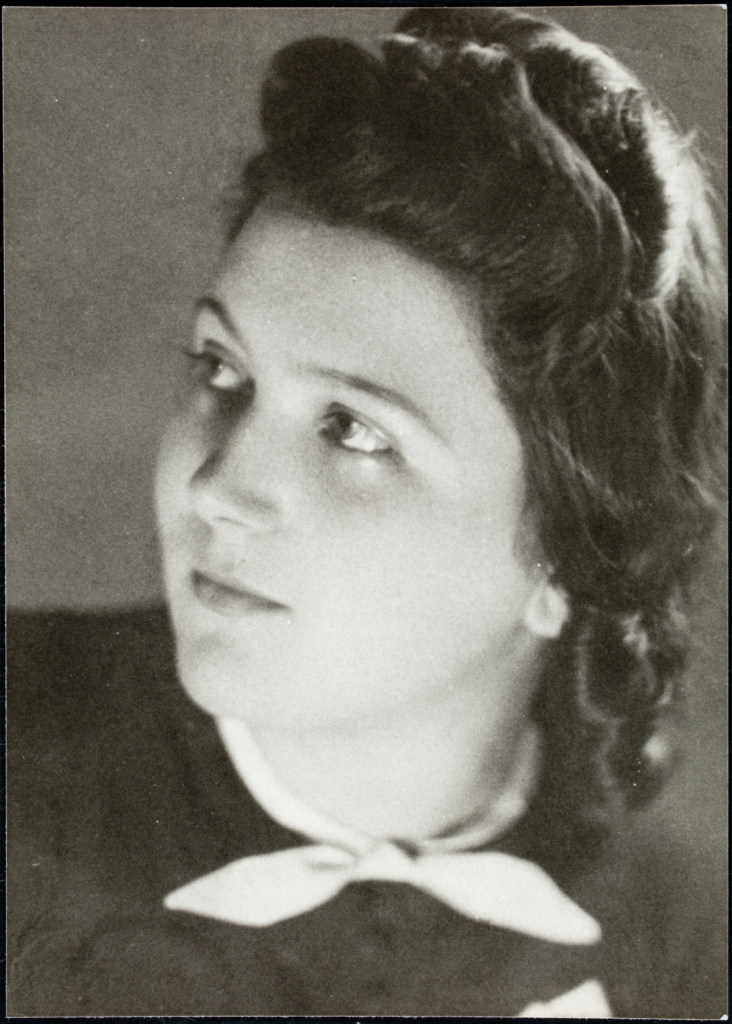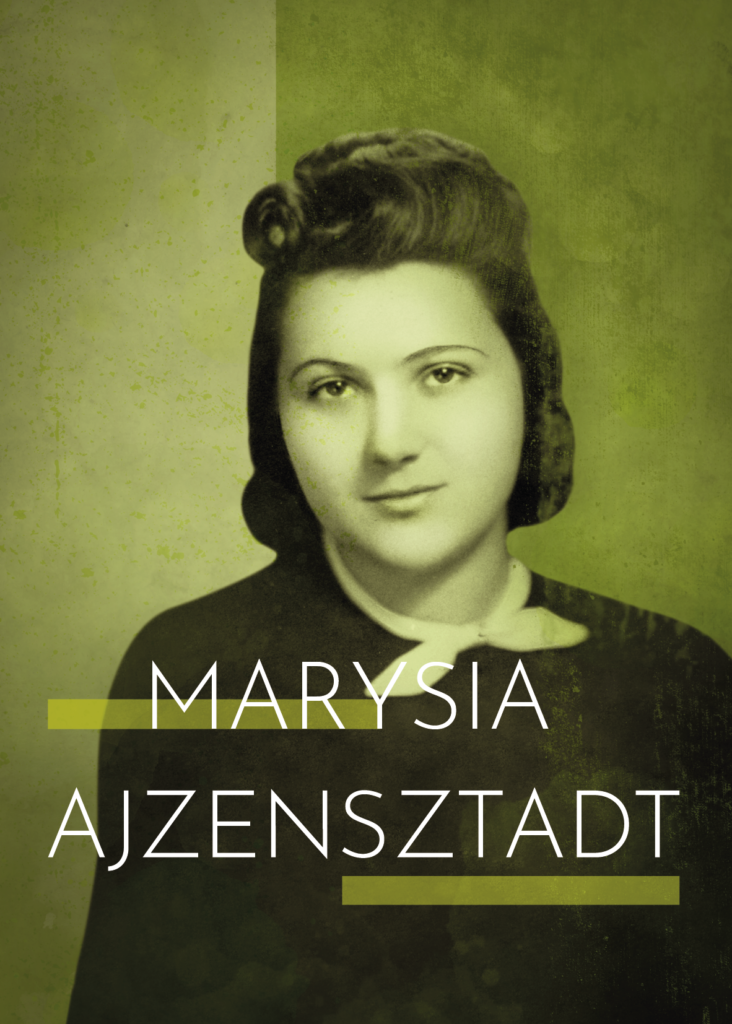VI 1921 (or 1922), Warsaw – 10 VIII 1942, Warsaw Ghetto/ Umschlagplatz (collection point)
Biography
Marysia Ajzensztadt was a young singer known as the “nightingale of the ghetto.”
She was a gifted lyric soprano, with a great vocal range and timbre. She performed at the Femina Theatre and in Sztuka café, which were both important venues for the burgeoning culture of the Warsaw Ghetto. Her repertoire included songs in Yiddish and Hebrew, as well as opera arias and popular hits.
Maria (Miriam) Ajzensztadt was born in June 1921 or 1922 in Warsaw. She is commonly remembered under the diminutive form of her given name – Marysia. She was the only daughter of the musician and composer Dawid Ajzensztadt who was the conductor of the boys’ and men’s choir of the Great Synagogue on Tłomackie Street. Music was a constant presence in Marysia’s life. Her father was responsible for her musical education and wanted her to become a pianist, but her deepest desire was to sing. Before the war broke out, she graduated from a “Yehudiya,” lower secondary school for girls (located on Długa Street in Warsaw).
In 1940, the Ajzensztadt family was forced to relocate to the ghetto. Music played an important role in the lives of Jews trapped inside and was commonly heard in its streets, theatres, and cabarets. This is where Marysia began singing professionally, earning money to support her family. In December 1940 at the Melody Palace Theatre on Rymarska Street, she made her debut. Soon thereafter, it was said that she would become the greatest voice of her time. She was a very talented vocalist, with a soprano voice, beautiful timbre, and great range and technique. Her awe-inspiring talent brought her great acclaim and huge popularity. Her repertoire included songs in Yiddish and Hebrew, arias from operas (by such masters as Verdi, Mozart, Puccini, Rimsky-Korsakov, and Rossini), as well as popular hits of the era. Most often, she sung at the Femina Theatre and in Sztuka café, which were both important venues for the burgeoning culture of the Warsaw Ghetto. Her appearances attracted huge crowds. Her rendition of the song Eli, Eli Lama Azavtani (‘My God, My God, Why Have You Forsaken Me’), which she sang at the behest of the Nazis, was recorded in a propaganda film about life in the ghetto.
Marysia was killed at the start of the first action liquidating the ghetto in August 1942 (either on 9 or 10 August). According to one account, she was shot when the Germans were removing her father from where they were living; according to another, she was killed at the Umschlagplatz (collection point) as she was getting into the cattle car. The 2013 March of Remembrance was dedicated to the memory of Marysia Ajzensztadt.
Sources:
Batorski Przemysław, Marysia Ajzensztadt, słowik getta warszawskiego, https://www.jhi.pl/artykuly/marysia-ajzensztadt-slowik-getta-warszawskiego,701 (25 January 2023).
Engelking Barbara, Leociak Jacek, Getto warszawskie. Przewodnik po nieistniejącym mieście, Warsaw 2013.
Virtual Shtetl, https://sztetl.org.pl/pl/miejscowosci/w/18-warszawa/120-aktualnosci/59926-zgasla-gwiazda-marysia-miriam-ajzensztadt (25 January 2023).
Marysia Ajzensztadt was a young singer known as the “nightingale of the ghetto.” She was a gifted lyric soprano, with a great vocal range and timbre. She performed at the Femina Theatre and in Sztuka café, which were both important venues for the burgeoning culture of the Warsaw Ghetto. Her repertoire included songs in Yiddish and Hebrew, as well as opera arias and popular hits.
Maria (Miriam) Ajzensztadt was born in June 1921 or 1922 in Warsaw. She is commonly remembered under the diminutive form of her given name – Marysia. She was the only daughter of the musician and composer Dawid Ajzensztadt who was the conductor of the boys’ and men’s choir of the Great Synagogue on Tłomackie Street. Music was a constant presence in Marysia’s life. Her father was responsible for her musical education and wanted her to become a pianist, but her deepest desire was to sing. Before the war broke out, she graduated from a “Yehudiya,” lower secondary school for girls (located on Długa Street in Warsaw).
In 1940, the Ajzensztadt family was forced to relocate to the ghetto. Music played an important role in the lives of Jews trapped inside and was commonly heard in its streets, theatres, and cabarets. This is where Marysia began singing professionally, earning money to support her family. In December 1940 at the Melody Palace Theatre on Rymarska Street, she made her debut. Soon thereafter, it was said that she would become the greatest voice of her time. She was a very talented vocalist, with a soprano voice, beautiful timbre, and great range and technique. Her awe-inspiring talent brought her great acclaim and huge popularity. Her repertoire included songs in Yiddish and Hebrew, arias from operas (by such masters as Verdi, Mozart, Puccini, Rimsky-Korsakov, and Rossini), as well as popular hits of the era. Most often, she sung at the Femina Theatre and in Sztuka café, which were both important venues for the burgeoning culture of the Warsaw Ghetto. Her appearances attracted huge crowds. Her rendition of the song Eli, Eli Lama Azavtani (‘My God, My God, Why Have You Forsaken Me’), which she sang at the behest of the Nazis, was recorded in a propaganda film about life in the ghetto.
Marysia was killed at the start of the first action liquidating the ghetto in August 1942 (either on 9 or 10 August). According to one account, she was shot when the Germans were removing her father from where they were living; according to another, she was killed at the Umschlagplatz (collection point) as she was getting into the cattle car. The 2013 March of Remembrance was dedicated to the memory of Marysia Ajzensztadt.
Sources:
Batorski Przemysław, Marysia Ajzensztadt, słowik getta warszawskiego, https://www.jhi.pl/artykuly/marysia-ajzensztadt-slowik-getta-warszawskiego,701 (25 January 2023).
Engelking Barbara, Leociak Jacek, Getto warszawskie. Przewodnik po nieistniejącym mieście, Warsaw 2013.
Virtual Shtetl, https://sztetl.org.pl/pl/miejscowosci/w/18-warszawa/120-aktualnosci/59926-zgasla-gwiazda-marysia-miriam-ajzensztadt (25 January 2023).
Anna Błaut wykonuje Na pierwszy znak (słowa: Julian Tuwim, muzyka: Henryk Wars), znany szlagier śpiewany w getcie przez Marysię Ajzensztadt (Bente Kahan, Pieśni z getta, 2013). Fortepian: Tomasz Kasiukiewicz; klarnet: Igor Pietraszewski
 Marysia Ajzensztadt, ze zbiorów Żydowskiego Instytutu Historycznego im. Emanuela Ringelbluma
Marysia Ajzensztadt, ze zbiorów Żydowskiego Instytutu Historycznego im. Emanuela Ringelbluma

